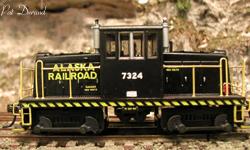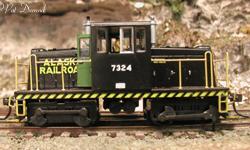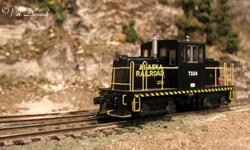 |
 |
 |
 |
 |
 |
Building GE 45 Ton ARR #7324 by Pat Durand Oct 2008
Four GE 45 tonners came to the Alska Railroad in 1974 as surplus from the US Army Transportation Corp. All these units were built for the Army in 1942 and carried numbers 7331, 7249, 7356 and 7324. The facts regarding their use in Alaska are sparse. It is believed some were used in Valdez during the construction of the Aleyeska Pipeline to move loaded cars from the dock to the pipe coating plant and then back to barges headed for Whittier. For the most part they sat around until retired in 1983. At that time 7356 was leased for a short time to the North Pole refinery. Eventually three of the units were sold to the Celatchie Prairie RR.
#7324 GE Builders Number 15247 remained in Alaska and found its way onto the Birchwood Powder Spur where vandals had their way with her. Every piece of glass was broken and 50 caliber holes were found in the cabinet doors and the cummins engine blocks. The brass radiators and copper were stripped from the loco. She was donated to the Museum of Alaska Transportation and Industry, and is now on display at Wasilla.
Bachmann Spectrum HO GE 45-ton switcher Item NO.85203 provided the spark for modeling 7324. Ed Coopers photo from the summer of 1977 set the prototype. Considering the little service these locomotives actually saw I decided to model 7324 as if it has been restored and is still in service by MATI at the museum.
Some minor steps were taken to animate the model. Remove all the visible screws (6) from the bottom including the coupler screws. Pull the couplers and pockets out each end and the body casting will slip right off. The hoods are cast as one metal part. The cab can be spread and pulled up and off after pulling out the two exhaust stacks that are also metal. Using flat tweezers pop up the hand rails and set them aside.
Using a sharp #11 blade I carefully cut out the cab door on the operators side and salvaged it to be reinstalled in the open position. Open one sliding window on the operators side. Remove all the windows and mask the headlight lenses for painting. The exhaust stacks have flapper caps that can be improved by opening them to about 45 degrees. Insert a # ll blade just under the flapper and press into the metal casting but do not cut all the way through. The flapper can be bent up with the edge of the blade.
Mask the trucks and the motor assembly and circuit board to protect them from overspray. Floquil Engine Black was the base color. CNW yellow PolyS was used to paint the steps and details. PolyS Reeding Green was used to trim the interior of the cab, control stand and door.
Herald King decal set NO DS-3 Diesel side sill 4" hash marks provided the exact count of 25-26 decals at 45 degrees for the side sill. White cab numbers are block style. The ALASKA RAILROAD for use on the hood is problematic. The photo shows this as white and in a very tight spaced block style. In my junk decal box there appeared a yellow version that is close. I surmise the museum thought yellow would be more appropriate during their restoration. A light swipe with a stiff brush loaded with Doc O'Brien's white highlight chalk brings out the details of the side rods, truck frames and radiator shutters.
AWE part #206 fire Extinguisher was installed on the rear pilot, a practice followed by the ARR in early diesel days. On assembly you may need to ream the holes for the grab irons to remove extra paint. Couplers were upgraded to Kadee #153 short shank whisker types.
Two evenings invested in this project added one more unique locomotive to my
ARR Roster.